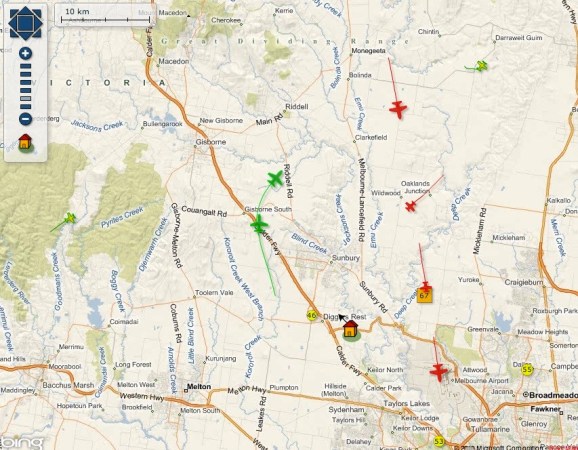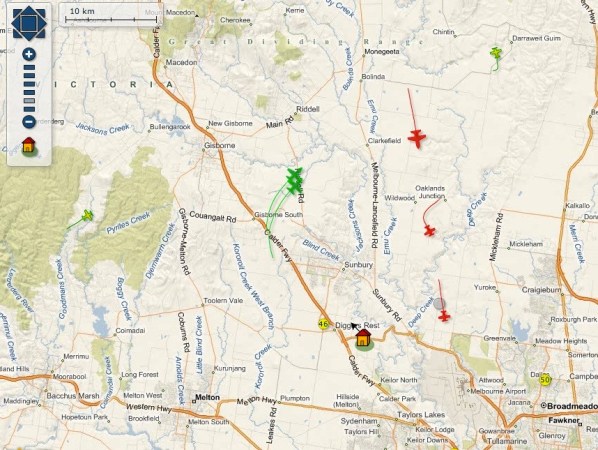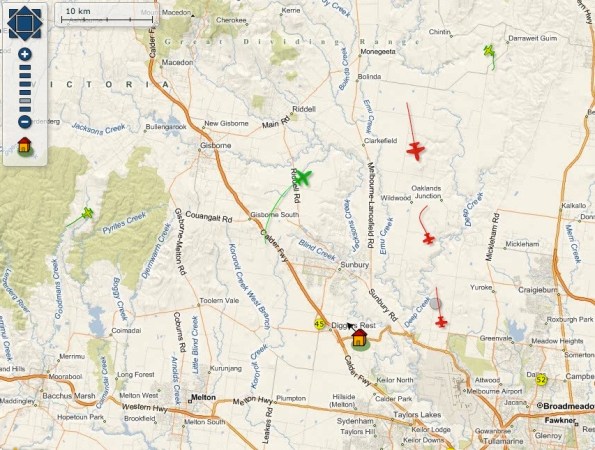The WebTrak site shows the vertical separation of the Virgin Blue 737 and a Qantas 767 during Sunday afternoon’s near miss while climbing away from Melbourne Airport as being as little as 28 metres.
That near miss is under investigation by the ATSB, as reported in the earlier posts (scroll down) on Plane Talking.
To recap, the ATSB notification says:
The two aircraft were tracking on the same route when separation reduced to 1.9 NM horizontally and 300 ft vertically. Separation standards were infringed. The investigation is continuing.
A report has not yet been released for this investigation.
The ATSB has been unable to identify the Virgin Blue jet involved all day, but the truth was made apparent by going to the WebTrak Melbourne page and using the tools on the left hand side of the screen to select flights archived on December 5 from, say 2.20 pm, when it starts to get very interesting to watch the Virgin Blue flight, DJ331 to Brisbane, being tagged, overtaken by and then merged with the icon representing Qantas flight QF438 to Sydney at 2.22 plus 14 seconds.

Shortly afterwards, just before 2.22 plus 23 seconds, the Virgin Blue icon suddenly disappears never to return. Fortunately this was just a radar tracking ‘effect’ not a real collision, but it does in a split second recreate the worst thing you could ever see on a web tracking system accessible in real time on the internet.
This is what is known about the events. Both jets departed Melbourne airport under the professional care of AirServices Australia on Sunday afternoon, Virgin Blue DJ331 for Brisbane leaving at 2.07 pm followed shortly afterwards by Qantas Cityflyer QF438 for Sydney. Both jets, the Virgin Blue narrow body and the Qantas wide body, follow very close tracks towards Digger Rest before turning right towards what seem like near identical headings on the busy northbound corridors that jets follow to Canberra, Sydney and Brisbane, depending on clearances from air traffic control.
The green line behind each jet’s icon represents their previous 30 seconds of track.
At 2.21 pm plus 47 seconds both jets are drawing close, with the Virgin Blue 737 at 2789 metres and the Qantas 767-300 catching up with and rising below it at 2647 metres. There is a difference of 142 metres in vertical altitude although slight displacement to the side is apparent on the screen.

At 2.22 pm plus 14 seconds , shown above, the jet icons are overlapping, with the Virgin Blue jet at 2908 metres (top icon) and Qantas at 2880 metres, a difference of only 28 metres in vertical separation. The 767 is climbing at a faster rate than the Virgin Blue jet.

At 2.22 pm plus 23 seconds, above, the Virgin Blue icon has vanished in the twinkling of an eye, but the Qantas altitude has reduced to 2851 metres, and this gradual loss of altitude continues until 2.23 pm and 50 seconds when it has descended to 2603 metres. By 2.24 pm and one second WebTrak is showing a resumption of climb by the Qantas jet, at 2641 metres.
By placing your cursor over each green icon you can read the flight details and altitude.
A spokesman for Virgin Blue said its pilots had followed all the instructions given by air traffic control and had not at any stage been advised of the potential for an infringement of separation rules. They were aware of the Qantas flight but had not spoken to it by radio. (As they wouldn’t in a busy corridor when active separation by air traffic control is taking place.)
It is understood that the Qantas pilots were also aware of the Virgin Blue flight and that they reported the infringement of separation standards promptly.
The ATSB has recently published its findings in the case of a Victorian airspace near miss between an Emirates 777 and a Qantas 737 near Swan Hill in which it reported bluntly on the training standards of the newly inducted air traffic control officer who was responsible for the separation of both flights.
It is an extraordinary and disturbing report, and one in which the ATSB flagged its strong interest in at least two other separation incidents, one involving a Cathay Pacific A330 and a Virgin Blue 737 near Darwin, and another involving a Qantas 767 Cityflyer and a Tiger Airways A320 over Tamworth.
This additional investigation, into in last Sunday’s Melbourne near miss, which the ATSB classifies as a ‘serious incident’, cannot fail to be of absorbing relevance to the safety of airliners in controlled space in Australian skies.







Crikey is committed to hosting lively discussions. Help us keep the conversation useful, interesting and welcoming. We aim to publish comments quickly in the interest of promoting robust conversation, but we’re a small team and we deploy filters to protect against legal risk. Occasionally your comment may be held up while we review, but we’re working as fast as we can to keep the conversation rolling.
The Crikey comment section is members-only content. Please subscribe to leave a comment.
The Crikey comment section is members-only content. Please login to leave a comment.